The software-as-a-service (SaaS) industry is growing rapidly and becoming increasingly competitive. For SaaS companies, establishing a unique competitive advantage is crucial. Implementing a tailored SaaS pricing strategy effectively sets companies apart. This approach not only boosts operational efficiency but also enhances profit margins.
Choosing the optimal SaaS pricing strategy requires careful consideration of various factors. These include the services offered, the target market, the business cycle stage, and the scale of operations. Understanding the significance of SaaS pricing is essential. It’s important to explore various strategies to effectively optimize your approach.
This guide will review the common SaaS pricing models. It highlights the differences between these models and broader strategies. It also discusses best practices for refining your pricing framework over time.
What Is SaaS Pricing?
SaaS Pricing is a broad term used to describe the way(s) in which software-as-a-service companies choose to charge their customers. There are many different types of SaaS pricing models available, including flat-rate pricing, feature-based pricing, and hybrid-pricing models.
The SaaS pricing strategy you use will influence the strategic and financial choices being made, while the SaaS pricing model you use will influence the logistics required to put the strategy into motion.
The primary objective of SaaS pricing, as you might expect, is to maximize profit. However, choosing the right strategy is not always so straightforward. For example, is it better to pursue more customers at a lower price or accept fewer customers at a higher price?
The answer to this question will almost always vary by company. This is why comparing multiple different SaaS pricing strategies is crucial before making any final decisions.
How Do SaaS Pricing Strategies Compare To SaaS Pricing Models?
The term “SaaS Pricing Strategy” broadly describes the approach being used when developing a pricing plan. The term “SaaS Pricing Model” describes the specific system that will be used to charge future customers and generate revenues.
Simply put, the pricing strategy describes the “why” while the pricing model describes the “how.” As you’d probably expect, the pricing strategy and model will strongly influence the other.
There are several things a SaaS company might keep in mind when developing its approach to the market.
For example, the company might be willing to accept a negative bottom line for a time in exchange for developing a stronger customer base that will ultimately lead to future profits.
This is especially true within the SaaS and fintech industries, where broader market penetration must almost always come before sustained value generation.
Why Is It Important To Get Your SaaS Pricing Strategy Right?
The price you charge, in addition to the quality of the service being provided, will directly affect how many people choose to become customers. If your product is incorrectly priced, you might end up alienating a large portion of potential customers or you might end up missing out on opportunities to earn a profit.
There are several variables that can cause a SaaS company to choose the wrong pricing for their business:
- Pressure from shareholders and other relevant parties to maximize profit now, rather than think about sustaining a profit in the future
- The ongoing temptation to replicate an already existing company’s pricing model and successes
- The natural preference to choose the simplest solution, rather than choose the solution that is truly best for the company
- Incorrectly valuing fixed expenses, variable expenses, and other line-items that will affect your company’s income statement and bottom line.
Each of these hazards can be uniquely problematic for SaaS companies. Making an effort to think about your long-term goals, your current market position, your target market, and company-specific challenges will make it easier to find a pricing strategy that effectively meets your needs.
What Pricing Models Exist For SaaS?
Here is a quick overview of the various SaaS pricing models, along with their pros and cons:
|
Pricing model |
Pros |
Cons |
|
Freemium |
|
|
|
Flat-rate pricing |
|
|
|
Usage-based pricing |
|
|
|
Tier-based pricing |
|
|
|
User-based pricing |
|
|
|
Feature-based pricing |
|
|
|
Credit-based pricing |
|
|
|
Hybrid pricing |
|
|
1. Freemium pricing
The Freemium pricing model offers a compelling way to monetize an organization. It provides certain features for free while charging for advanced functionalities. Users can start at no cost, encouraging broad adoption. They may then opt to upgrade to premium versions.
The model’s success depends on a careful balance between free and paid features. The free version must attract users and encourage them to pay for additional capabilities. This often involves testing different features and price points to find the optimal setup.
At the heart of the Freemium model is a focus on customer engagement. Companies can build a large user base by offering substantial value for free. As users become more invested, they are encouraged to switch to paid plans.
This approach removes the entry barrier. Users can experience the service before making a purchase. Maintaining many free users can be costly. However, converting even a small fraction to paying customers can increase revenue.
Dropbox, Slack, and Canva exemplify the Freemium SaaS model. Each offers a basic service for free to attract users. They provide enhanced features at a premium to encourage upgrades and generate revenue.
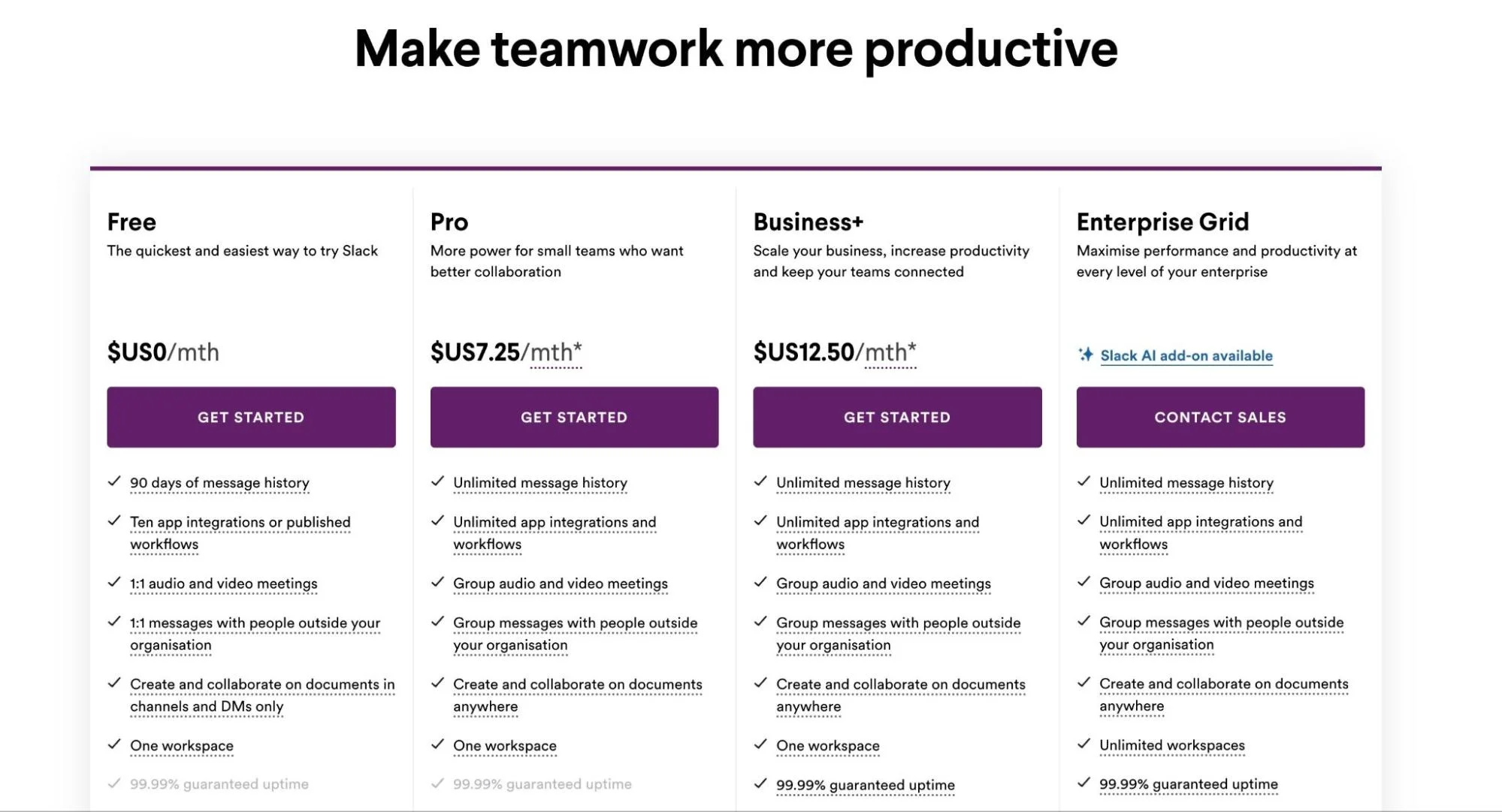
Slack’s freemium model offers basic access for free, with tiered paid upgrades.
2. Flat-rate pricing
The flat-rate pricing model, as the name might suggest, is the most straightforward model. With flat-rate pricing, there is only one available price and the only variation is in the software that’s offered.
There are several benefits to using a flat-rate pricing model. First and foremost, the flat-rate price is the easiest to market because you can clearly explain the price in all marketing materials. Additionally, because flat-rate pricing is so simple, it also makes it easier to project future derivatives (such as revenue growth, churn rate, lifetime customer value, etc.).
However, the simplicity can also be problematic: a one-size-fits-all solution might price some customers out and also cause others to feel that their needs aren’t being met. This is why many SaaS companies look to other pricing models.
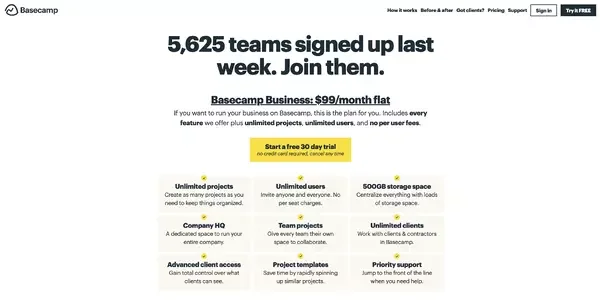
Basecamp’s flat-rate pricing model offers a clear price and benefits for each of its customers — regardless of their personal needs.
3. Usage-based pricing
A use-based pricing model is one in which the amount each customer pays depends on how much software (or related products) they use.
The pricing model is also often referred to as the “pay-as-you-go model.” The usages can be quantified in several different ways, including payment per action, payment as a percentage of revenue made, payment per transaction processed, or payment for storage usage.
Many people find the usage-based pricing model appealing because it seems to be the fairest: the more you use, the more you pay, and the less you use, the less you pay. With the usage-based pricing model, expenses will fluctuate over time. However, these fluctuations are rather predictable. Both small and large users might find the model appealing.
On the other hand, the most obvious drawbacks of the model are that customers might not be able to forecast how much they will need to pay and there might be a disconnect between real and perceived value.
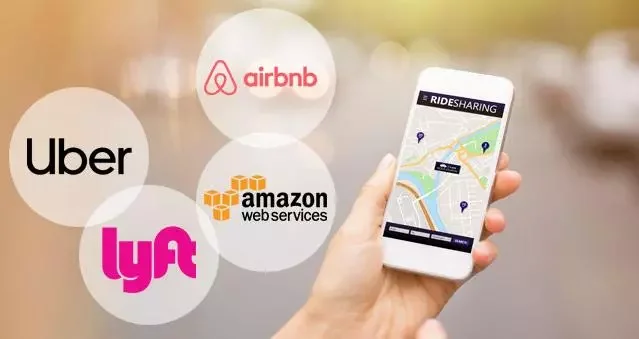
Uber, Lyft, Airbnb, and AWS are all tech companies that rely on the usage-based pricing model — the more you use them, the more you pay (Photo via BillingPlatform).
4. Tier-based pricing
Many SaaS companies feel that their customer base falls into several specific “tiers.” In response, they might consider creating a pricing model that includes three or four tiers, each with a specific customer base in mind.
The tiers might include a “freemium” entry in which a basic version of the software is offered for free and an advanced tier that includes all of the possible features available.
The primary benefit of using tier-based pricing is that you can appeal to a wider range of possible customers. Some customers might have very simple, low-scale needs while others will have considerably more sophisticated needs. The tier-based pricing model adjusts accordingly.
At the same time, some may find the tier-based system either difficult to navigate or frustrating to use. Users will often be drawn to the low price of the entry tier at first, only to eventually realize they need additional features. If you choose to use this model, clearly communicate what each tier includes and how much it costs.
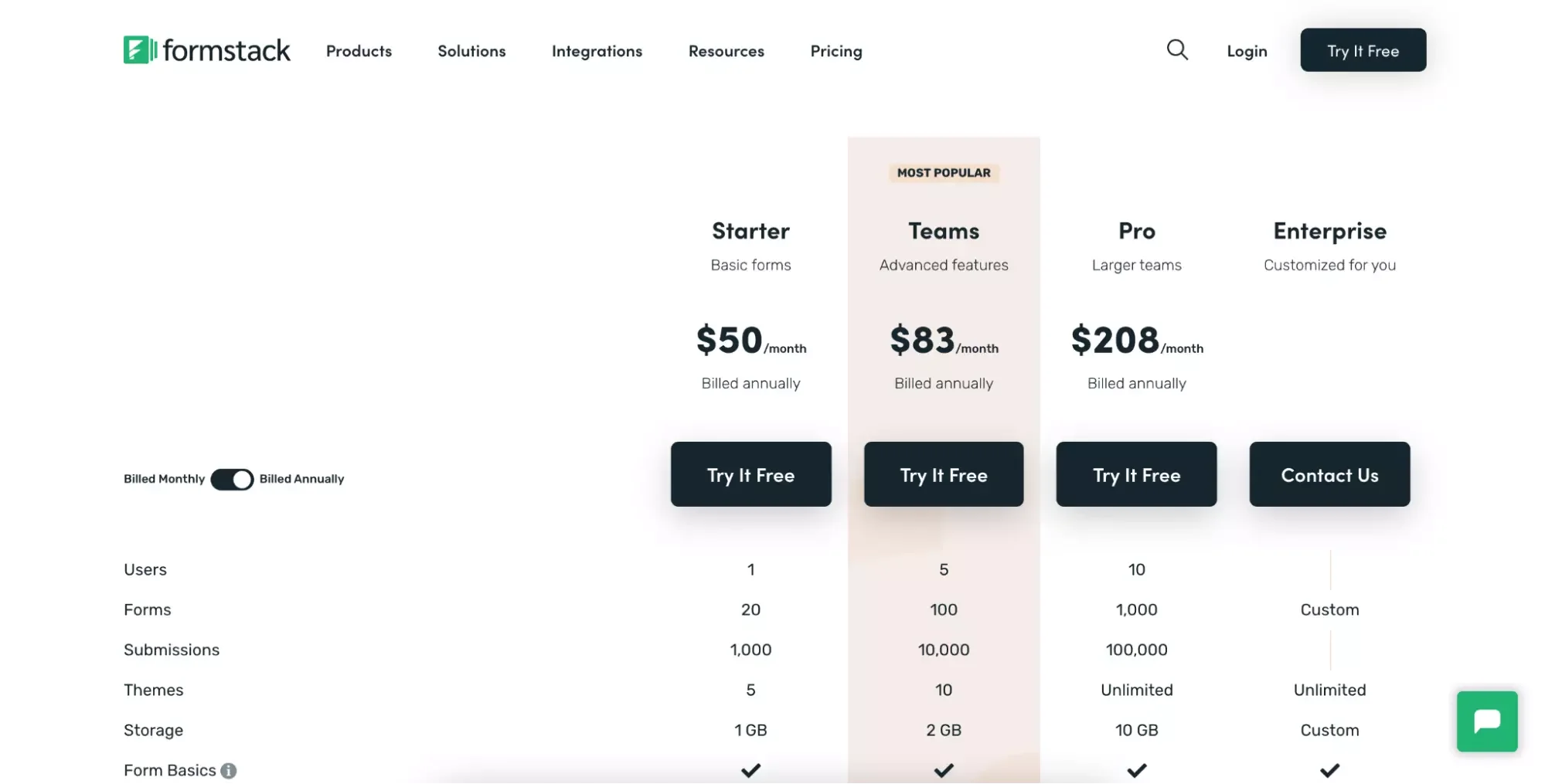
The tiered-based pricing model from Formstack features four different pricing options.
5. User-based pricing
When a company invests in a software product, they will need to consider how many people can use the product at once. In other words, they will need to consider how many users will be included.
The user-based pricing model is a system in which the amount you pay is directly related to the number of users your company includes.
User-based pricing is very straightforward. The more users (or seats you have), the higher the plan price. When people are dropped or otherwise excluded from usage, costs will decrease.
The system — and its corresponding predictability — is an excellent option for companies that plan to scale in the near future. The biggest drawback of the user-based pricing model is that because adoption increases expenses, the adoption rate might be decelerated.
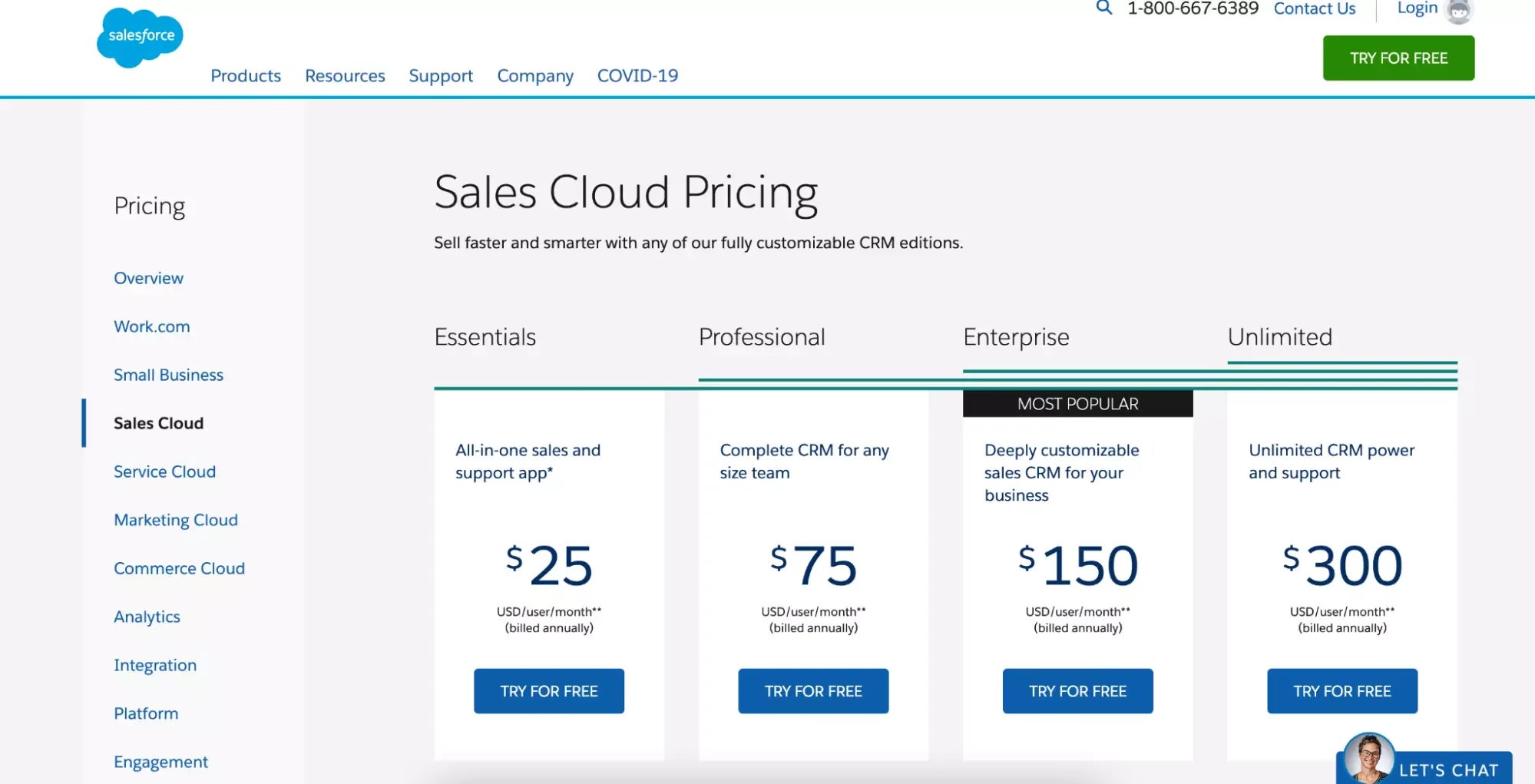
Salesforce uses a per-user pricing model in their Essentials, Professional, Enterprise, and Unlimited plans.
6. Feature-based pricing
Using the feature-based pricing model allows companies to pay for each specific feature they use. The features are often marketed as “add-ons”, which can be easily accessed or customized as needed.
The feature-based pricing model, at its most basic level, is similar to the tier-based model in that customers who want more features will be expected to pay a higher price. However, the primary difference is that the features are typically separate from the standard packages, rather than simply tiered off.
The feature-based model is highly customizable, making it easy for companies to create a SaaS solution that can address their specific needs. It also offers a strong degree of flexibility — as companies scale and face new challenges, they can add or drop certain features as needed.
However, because many customers are reluctant to pay more, they might avoid any additional features, even if the feature could clearly offer their company additional value.
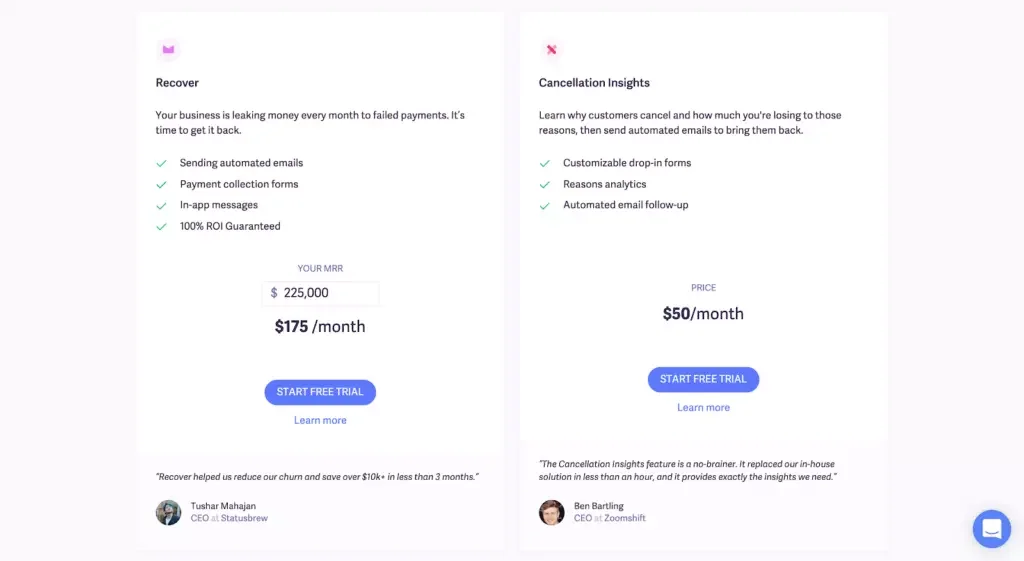
Baremetrics offers add-on features that increase monthly costs.
7. Credit-based pricing
The “credit” system is ideal for customers that know they will need to use a specific software product but are unsure when they will need to use it or the extent it will need to be used.
The credit-based pricing model involves the customer paying for a specific unit of usage upfront, enabling future usage on an as-needed basis. If their usage needs happen to increase, they will always have the option to purchase additional credits.
Credit-based pricing offers users a considerable level of control. Customers only need to pay for what they use, and they also have the right to use the product at a time of their choosing.
Additionally, customers pay before they have access to the product, which can help accelerate cash flow for the underlying SaaS provider. However, if a customer accumulates too many credits, they are likely to become disengaged and potentially drop the service altogether.
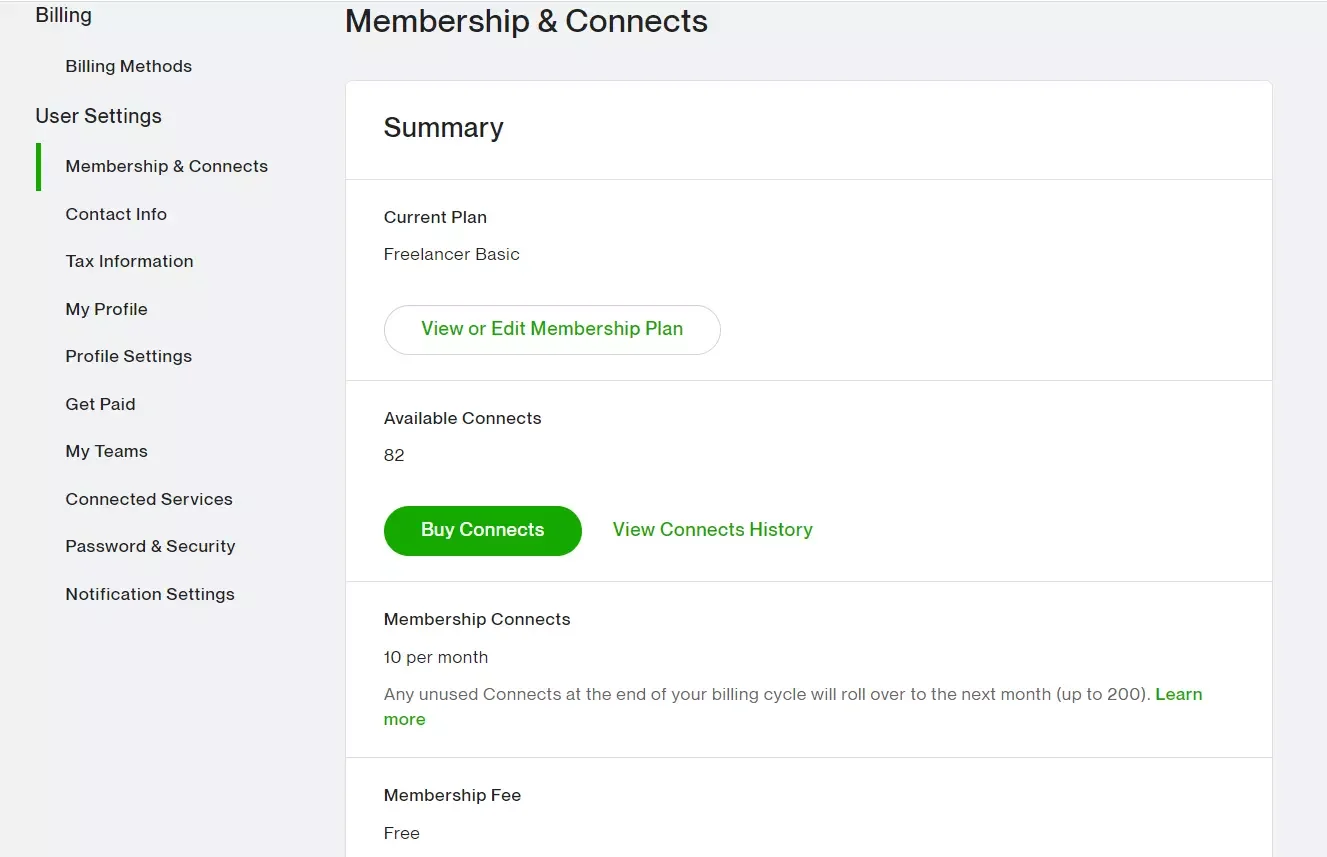
With Upwork, freelancers can purchase “connects”, allowing them to apply to more jobs whenever they want.
8. Hybrid pricing
Picking, choosing, and combining different systems can help companies find a pricing solution that is truly right for them.
A hybrid pricing model seeks to provide the benefits of several different systems while also neutralizing the drawbacks. For example, a company might consider blending the tier-based pricing model with a more personalized feature-based pricing model.
Such a system, which is used by companies like Drift, makes it easier for everyone to find a fair system for everyone involved. Of course, the most obvious drawback of hybrid pricing is that it can quickly become very complicated — if everyone is paying a different price, creating future forecasts and cashflow projections becomes considerably more difficult.
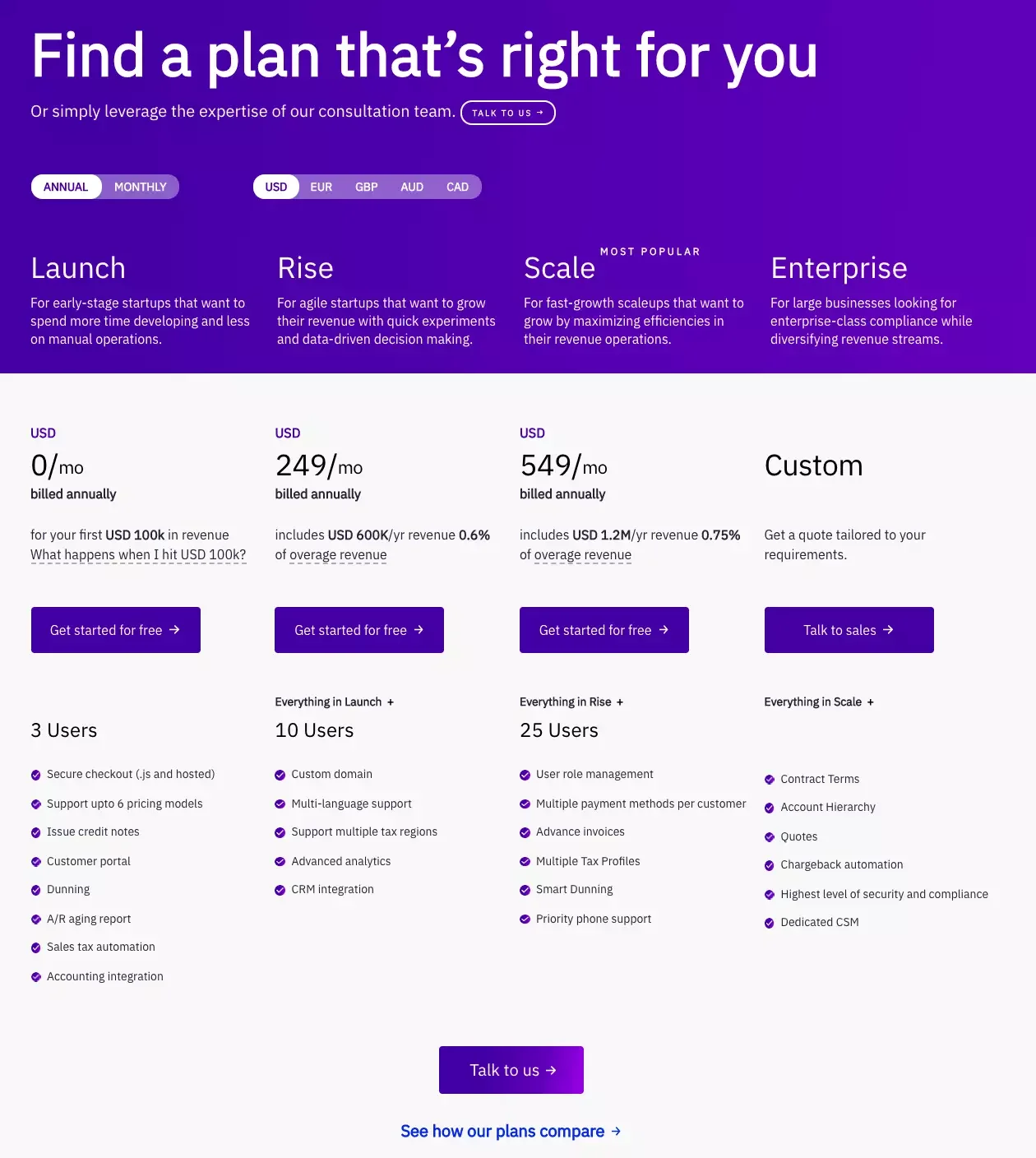
Chargebee is a company that combines the tier-based pricing model with the usage-based pricing model.
What SaaS Pricing Strategies Exist?
SaaS pricing strategies are not one-size-fits-all, but rather adaptable to different business needs and market entry stages. Here are several popular SaaS pricing strategies:
- Cost-plus pricing. This basic strategy sets prices by adding a profit margin to the costs. It’s simple but may not reflect the product’s value to customers.
- Competitor-based pricing. Prices are based on competitor charges. This method is useful for newcomers because it positions a product within market norms but may ignore internal value.
- Value-based pricing. This approach charges based on the perceived customer value, putting the customer at the heart of the pricing strategy. Prices are aligned with what customers are willing to pay, focusing on customer needs and value perception.
- Penetration pricing. Initial low prices aim to capture market share quickly. The strategy is to grow a large base and raise prices as brand loyalty builds.
- Captive pricing. Low prices for main products are set with high prices for essential add-ons. This strategy ensures initial affordability and profits from supplementary products.
- Skimming pricing. High initial prices are reduced over time to capture various market segments. This maximizes early adopters’ willingness to pay before targeting more price-sensitive customers.
- Prestige pricing. High prices convey quality and exclusivity, attracting status-conscious consumers and maintaining a premium brand perception.
- Free trial pricing. Offers free use for a limited time, encouraging trial and easy conversion to paid plans post-trial.
How Do You Choose The Right Pricing Strategy For Your SaaS Company?
Now that you are familiar with the different SaaS pricing models and strategies available, the next step is choosing one that makes the most sense for your business. When deciding on the right solution, begin by asking yourself the following questions:
- What service are we currently providing? What makes our service different from our competitors?
- Who currently owns equity in the company? As cash flows in and we accumulate more users, who gets paid first (and how much will they get paid, on the margin)?
- Who do we expect to be our primary target market? What motivates this market to make decisions or purchases? Who might become our secondary (or expanded) target market in the future?
- How do we expect people to typically pay for our services? Do we have a digital storefront, a physical storefront, agents, or any other payment outlets?
- What is our financial position in the status quo? What kind of SaaS company do we hope to become over the next ten years?
- How will you track the effectiveness of your current pricing model? How will you determine if any changes need to be made in the future?
Again, it is important to realize that there is not a universally “best” SaaS pricing strategy or model that will apply to every company.
If you are in the early stages of your company, it might be worth experimenting with multiple different approaches to pricing before making a final commitment. Nevertheless, taking the time to answer these specific questions can help put you in a position to make a choice that works well for you.
How Do You Track Your SaaS Pricing Strategy Over Time?
One of the keys to success as a SaaS enterprise is tracking your financial performance over time. This industry is highly data-driven and reliant on finding marginal ways to provide value.
The more you can do to understand how you are performing, the better prepared you will be to make any necessary adjustments.
Some of the most important KPIs you might consider include:
- Cost per customer – For SaaS companies, this cost is often defined by how customers use specific features within your software and the cloud costs that drive those features.
- Cost per feature – Understanding your cost per feature is also important as it will indicate which features of your business cost you the most and why.
- Churn rate – Describes how many customers stick with your business over time.
- Customer lifetime value – How much value does the average customer create for your company? Naturally, the relationship between total customer value and your corresponding pricing model will be very strong.
- Customer acquisition cost – How much does it cost, on average, to gain one additional customer? This figure will set a baseline for what your company needs to charge and will also influence your pricing strategy.
- Cash – This might be obvious to some, but access to cash (and other illiquid forms of capital) will really impact what your SaaS company is able to do. Additionally, understanding the relationship between available cash and needed cash flow might also influence which pricing strategy you end up choosing.
For tracking churn rate, customer lifetime value, and customer acquisition costs, there are many platforms you can use, like ChartMogul, to analyze your performance.
However, when it comes to measuring and monitoring your feature costs and how much specific customers cost your business, this can be much trickier to do.
Many SaaS companies use a cloud service provider like AWS to host and deliver their product to customers. But reading your AWS bill and seeing how costs translate to your business is a nearly impossible task. Your AWS bill tells you how much you spend but not the what, why, and how of that spend.
Using a cloud cost intelligence platform like CloudZero can help you uncover this vital cost data.
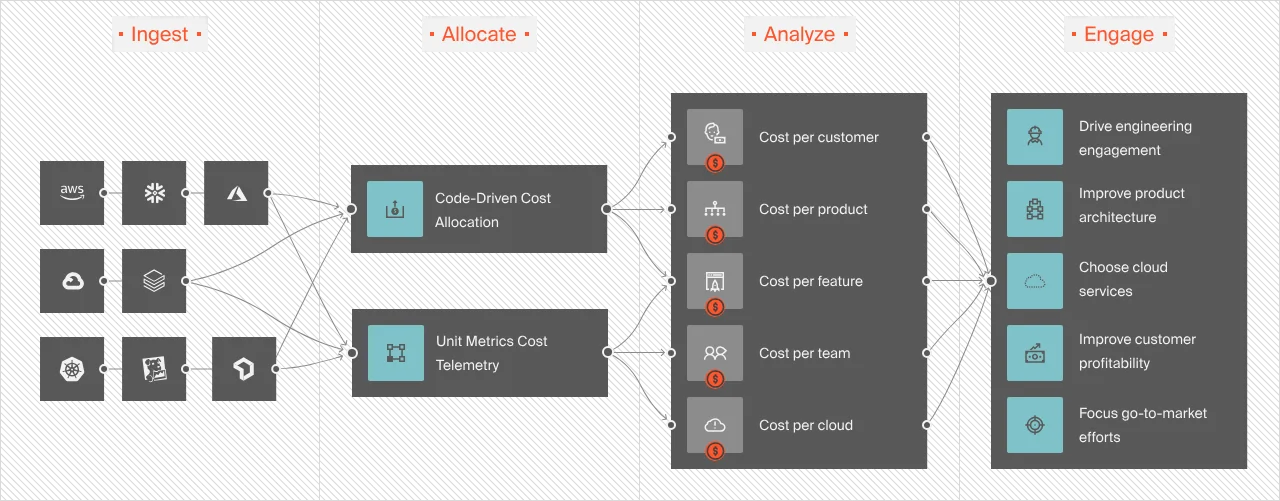
CloudZero is a cloud cost intelligence platform that enables SaaS companies to map cloud costs to products, features, teams, and more, as well as identify and monitor unit cost such as cost per customer.
For instance, CloudZero’s Cost Per Customer report allows teams to see how individual customers drive their cloud spend and how specific customers drive their feature costs.
CloudZero also enables engineering teams to drill into cost data from a high-level down to the individual components that drive their cloud spend — and see exactly what AWS services cost you them the most and why.
With detailed cloud cost intelligence, companies can make informed business and engineering decisions (like how to price your products and software) that will ensure profitability. To see CloudZero in action, schedule a demo here.
SaaS Pricing Best Practices
Be sure to keep these best practices in mind when implementing and evaluating your pricing model:
Be willing to change
Though you should put some serious consideration into your SaaS pricing model, you should never assume any of your decisions to be truly permanent. If evidence suggests you could be doing things more effectively, you should certainly be open to change.
At CloudZero, we can help you leverage data to better understand where your company stands in the status quo. Using key performance indicators, such as cost per customer, you can gain a comprehensive understanding of financial opportunities and threats.
Monitor your competitors
Keeping track of competitors’ pricing models can help you determine if your company is in alignment with industry norms (though this doesn’t necessarily mean you have to conform).
Connect with your Customers
Understanding the wants and needs of your current and prospective customers can help you find the optimal pricing model. What do they think of the model you are using in the status quo? Does it seem you’d be better off using a different system?
Know your business (and your industry)
Both your business and the broader SaaS industry are unique. Applying a universal business model can cause you to miss out on potential sales. Be sure that you understand your unique selling point, conduct a SWOT analysis, and take a closer look at industry-wide developments.
Create a cashflow timeline
The target cashflow timeline for SaaS companies can vary tremendously. While some businesses need to generate high-profit margins today, others can operate at a loss for a sustained amount of time. Knowing when you’ll need cash flowing in can help you craft the appropriate pricing model.
Measuring And Evaluating Your Chosen Pricing Model
Finding the right pricing model will take time — and that’s okay. However, rather than simply hoping you’ve already made the right choice, you should pay close attention to the situation at hand. As is usually the case, the more you can do to analyze and plan, the better off you will be.
For SaaS companies operating in the cloud, understanding your COGS and cost per customer are two metrics that are vital to determining the right pricing model and strategy for your business. For example, if you know that a specific customer segment costs your business more (e.g., SMB vs. Enterprise), you can adjust your pricing to accommodate for different usage across these segments.
Cloud spend is a big component of COGS and cost per customer for SaaS brands. Yet, uncovering this information from your cloud service provider (e.g., AWS) is nearly impossible. AWS provides you a bill that tells you how much you spent that month but not how and why. This is where a cloud cost intelligence platform, like CloudZero, can help.
CloudZero can help your SaaS company map costs to specific products, features, teams, and more, as well as identify cost per customer. With CloudZero, you’ll be able to see how much specific customers cost your business and why. With detailed cost insight, you can make informed decisions about your pricing that will ensure profitability.
To see how CloudZero can help your SaaS company measure cost per customer, unit cost, COGS, and more,  .
.








